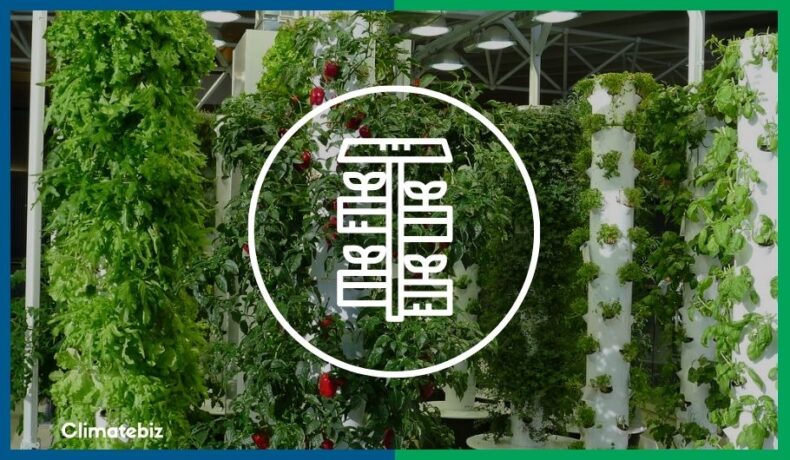There is only one expression to describe a tower garden – up, up, and away!
By ground or water, vertical tower gardening has provided an effective method of growing indoors or outdoors.
You can be sure to spot sprouting shoots or find fresh fruit ready for picking!
Finally, a way of gardening which allows you to bask in the sun’s glory or remain snug in your homes safe from the outer world!
Follow us as we navigate the lush loads of information on a home growing guide to vertical tower gardening!
Table of Contents
What Is A Tower Garden?
A tower garden (or grow tower) is one of the techniques used in vertical gardening systems.
If you drive around your local town or city, you’ll most likely spot an upwards growing beauty against a building or in a home.
Whether grown in soil or water, tower gardens are a great way to save space while growing the plants or vegetables you need!
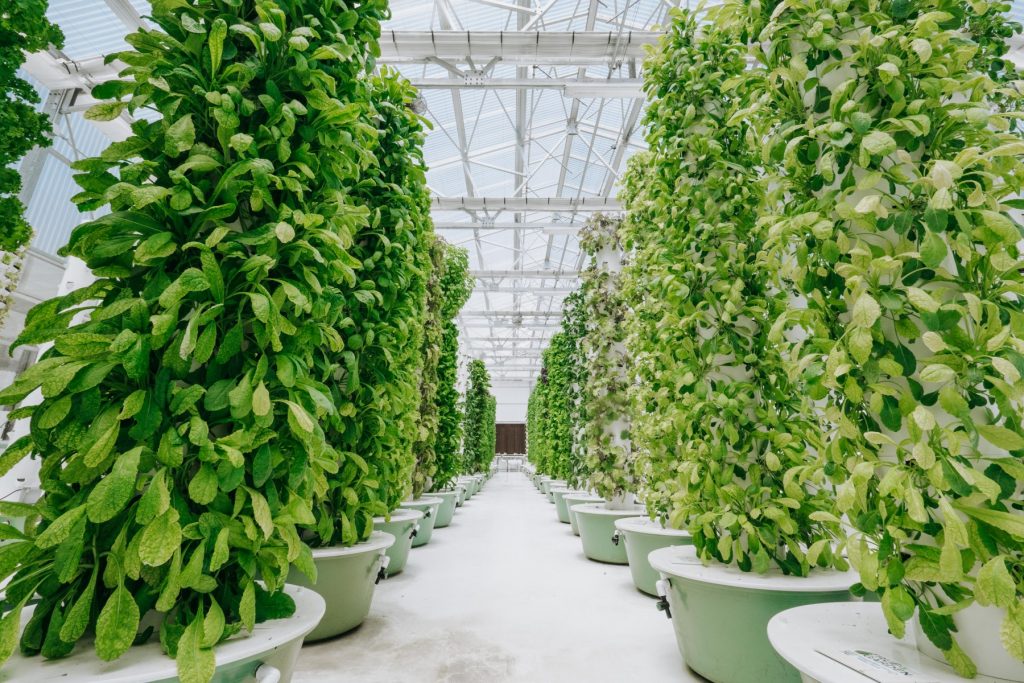
Source: Grateful
How Does A Tower Garden Work?
Basic Concept
A grow tower is designed to work with gravity.
Nutrients are dripped or sprayed over exposed roots inside the tower (aeroponics). In hydroponic systems, the roots are constantly covered with this nutrient solution.
A reservoir storage base is at the bottom of the tower, where it recaptures and recycles the water throughout the system.
Components
A complete system is made up of the following components:
| Component | Description |
|---|---|
| Nutrient Reservoir | The base structure at the bottom of your system holds the nutrient and mineral solution and the pump. |
| Pump | The pump within the nutrient reservoir delivers the nutrients and water to the top of the tower. |
| Net Pots | The pots secure plants into their positions while exposing the roots for nutrient absorption. |
| Tower Divisions | The vertical sections will hold the plants. |
| Cap or Shower Cap | The device on the top of the tower showers or sprays the nutrient and mineral solution down the plant roots. |
| Nutrients or Mineral Solution | A mixture of minerals and nutrients aids in plant growth and maintains plant health. |
| Lights (in the case of indoor systems) | The grow lights specific to your ordered system. |
Outdoor Vs. Indoor Tower Garden
If you plan to plant crops that bear fruit or larger green plants, you’ll prefer an outdoor tower garden.
Artificial grow lights are unnecessary in outdoor systems, making these systems a little less costly.
However, if you want to grow baby green vegetables, herbs, and indoor flowers, we recommend going with an indoor tower garden.
In this instance, you can replace natural light with artificial plant grow lights (such as 1000-watt LED lights). Just make sure to provide your plants with adequate amounts of light exposure to meet their individual needs.
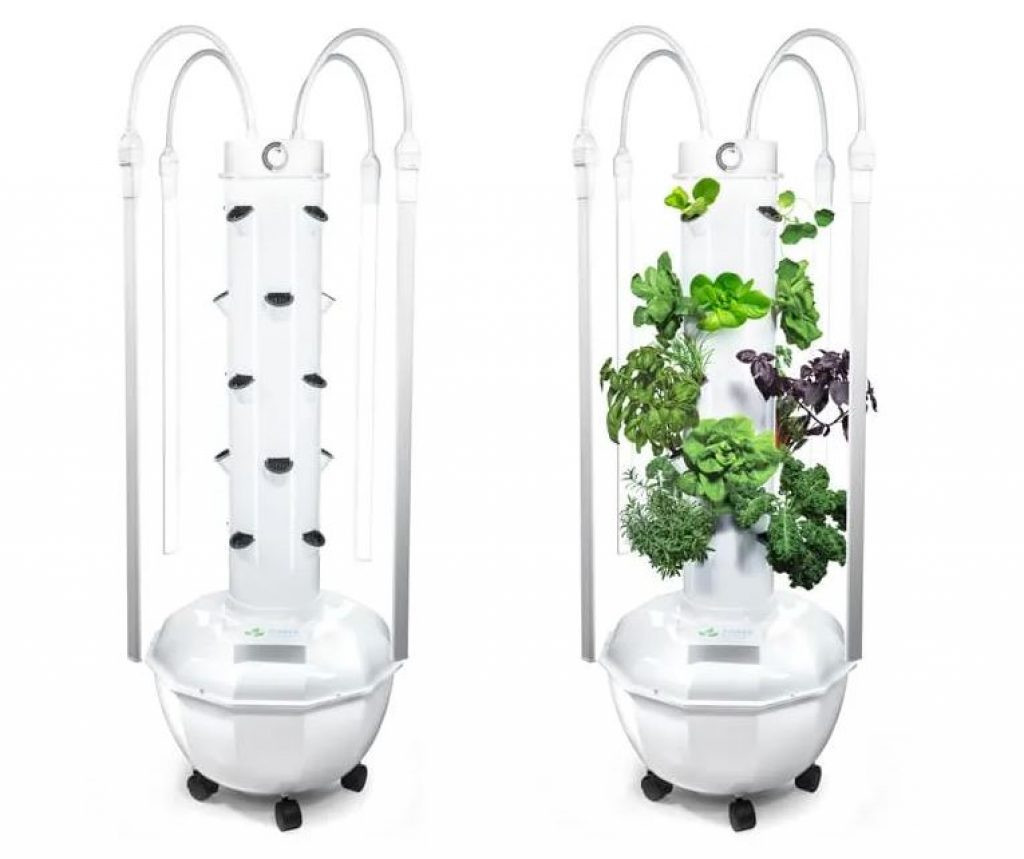
Source: Agrotonomy
In most cases, artificial lighting will be adequate to grow crops indoors. However, it can become costly if your crop requires 16-18 hours’ worth of light.
How Much Does A Tower Garden Cost?
There isn’t a straightforward here; you’ll need to conduct a cost breakdown of the required components.
A fully equipped vertical tower garden can cost over $500. This type of setup is available to order online and generally includes the entire system except for the planting medium and the plants themselves.
There is, of course, the option to build one yourself, and it may work out to be much cheaper. In fact, you can make one for as little as $50.
What Is Required?
Each unique system type requires its own infrastructure and materials to operate successfully. These may include:
- The types of framework (steel, plastic, wood, etc.)
- Your preferred irrigation system
- Professional installation services
- Maintaining and caring for your gardening system (an absolute must!)
Keep in mind that you’ll need to pay for nutrient solutions and other specialized mixes — this could cost you an extra $40 per year.
Other costs include equipment such as a pH kit and the cost of your plants. These are available online, and cheaper alternatives are right at your fingertips.
Reducing Costs
You can take additional measures to reduce costs.
For example, consider recycling your household water using a greywater system or rainwater collection to reduce water demand. This could bring down that hefty water bill by a reasonable amount.
Certain regions and states offer tax rebates for green energy and green practices. Incorporating solar to run your tower garden pumps could potentially have you saving more than you thought!
How Long Does A Tower Garden Last?
A home system can last you up to ten years!
However, the lifespan ultimately depends on the type of materials you use, how well you look after your structure, and the size of your grow tower.
If your vertical tower is exposed to the harsh sun all day, you can expect the plastics to perish faster than indoor towers or towers with partial sun exposure.
Regular maintenance is simply a must to keep the sections free of eroding molecules and get a good view of your tower’s condition.
Catching degradation early on will allow you ample time to replace a part if necessary!
What Grows Best In A Tower Garden?
Aside from ornamental plants, grow towers are great spaces to grow vegetables.
You may prefer to have one of these towers for visual aesthetics in your home or office space.
Should this be the case, the top ornamental plants for a grow tower include ferns, flowers, and succulents.
Vegetables will be a good option if you’re leaning more towards the self-sufficiency route. The best vegetables include beans, kale, lettuce, cucumber, zucchini, tomatoes, and many more!
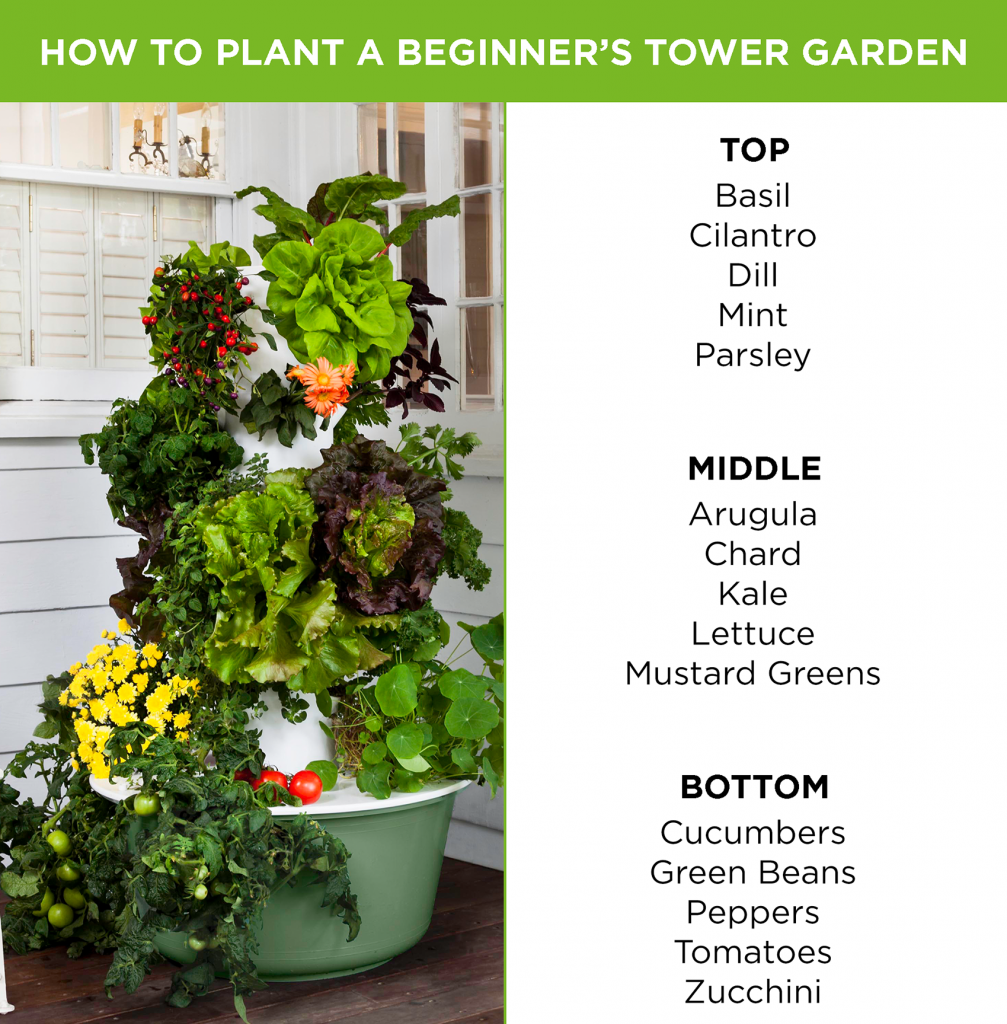
Source: Tower Garden
The great thing about growing vegetables in a grow tower is that it provides additional benefits such as an interactive form of learning and gaining knowledge around healthy consumption.
In fact, research shows that in a project where vegetables were grown as part of a kindergarten activity, children were more inclined to eat the vegetables as they watched them grow.
What Should You Not Grow In A Tower Garden?
Most plants and vegetables can be grown vertically.
It’s pretty common sense to think that the ones bearing heavier fruits or vegetables are harder to grow upwards. For example, melons are tricky to grow in a grow tower, and you would have to place netting to catch what may fall.
However, some characteristics generally warn you not to grow vertically.
Plants with intense root systems (such as potatoes) are not ideal for grow towers. They require a lot of root space for uptake, and you may find yourself struggling to get them going.
Moreover, potatoes are reasonably heavy, and you may see your tower come crashing down!
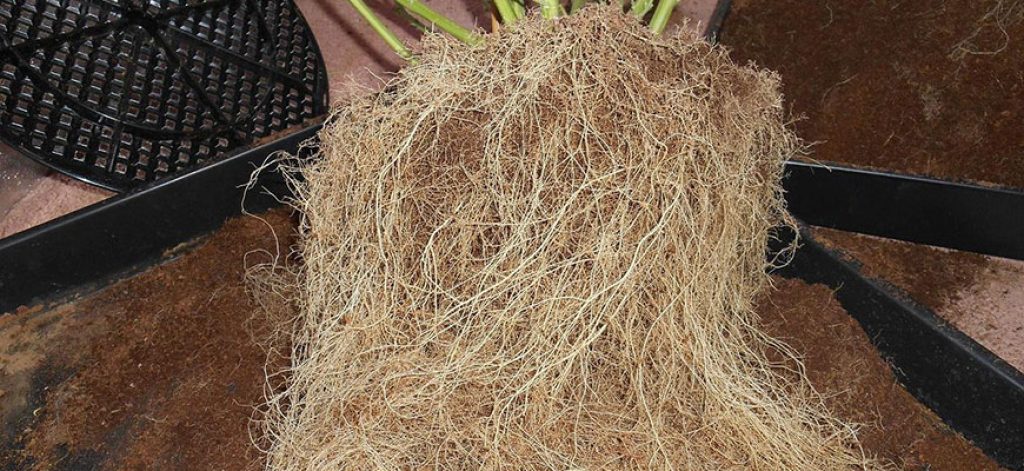
Source: Hydrobuilder
Roots aside, plants that generally need more space to grow should be avoided.
Let’s take corn, for instance.
Corn needs plenty of room to grow and wouldn’t be well-suited to your grow tower. In other words, your tower will most likely start resembling the Leaning Tower of Pisa sooner than you thought!
Where Is The Best Location For A Tower Garden?
The best location for your grow tower will largely depend on what you want to grow and where you plan to grow it!
Different types of plants prefer different levels of exposure to light and a range of temperatures. Here is an example of two contrasting vegetables:
| Vegetable | Optimal Environment |
|---|---|
| Green beans | Warmer weather with at least 6 hours of light |
| Leek | Cool-weather with bright light |
Looking back at the table, you’re likely getting the idea of what we’re trying to say!
If you live in a warm environment with optimal sunshine, look for plants suited to that climate, and vice versa.
If you’re planning on going entirely indoors, grow lights can be the perfect sunlight substitute and allow you to control your environment to a much greater extent.
How Do You Check The pH Level Of A Tower Garden?
The pH level of circulating water or the growing medium in your grow tower refers to how acidic or basic it is at that point in time.
It’s crucial to check the pH regularly because these levels will determine nutrient availability for the plants in your system.
pH testing kits are readily available and easy to order online. If you buy a fully equipped set-up, a testing kit is usually included with an instruction manual.
Checking the pH level boils down to extracting water or soil from your system and placing it on a pH testing strip. The testing strip will then indicate the current state’s color (depending on the type of strip used).
Alternatively, an electronic pH probe can be used; this device displays pH levels on a screen.
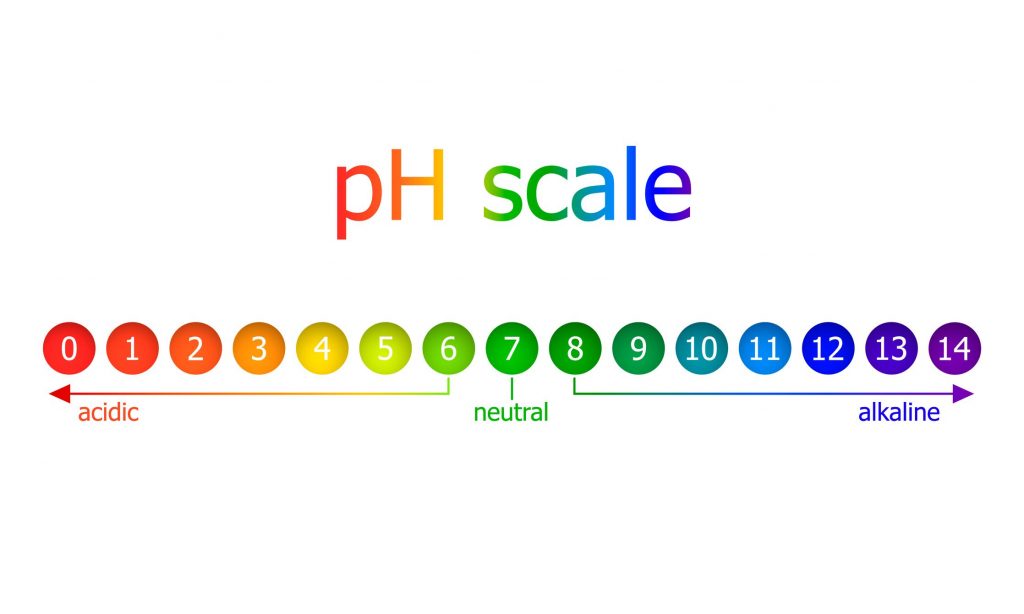
Source: Treehugger
How Do You Clean Your Tower Garden Correctly?
Maintaining and cleaning your tower garden is crucial for successful plant growth.
When unwanted algae and other critters start hiding in between plants and your failure to check for them, the result can be disastrous. In fact, your whole system can be infected and see an early end.
Scary stuff! So how can one prevent this? The answer is simple — regular maintenance and checks!

Source: BrieGrows
You should adhere to recommended tasks daily, weekly, monthly, and those which you must carry out twice a year.
Daily Tasks
- Keep a close eye on your plants for any 6-legged unwanted guests.
- Check to see if there is any yellowing or discoloration on any of your plant leaves.
- Make sure your reservoir pump is still completely covered in water.
- Ensure you adjust the nutrient and mineral ratio if you add water to your system.
Weekly Tasks
- Snip and prune plants that are growing rapidly.
- Snip and prune any roots that are growing too long.
- Harvest any plants that are ready.
- Keep a close eye on your system pH levels and maintain them accordingly.
Monthly Tasks
- Use a needle, toothpick or stick to keep the shower cap holes unclogged.
- Unplug your pump, remove the cover and clean it thoroughly with fresh water.
Biannual Tasks
This is where the deeper cleaning happens!
- Disassemble your tower into its relevant sections.
- Clean each section as you would monthly.
- Take the shower cap and the top lid off and clean with warm soapy water.
- Remove the entire pump and pump cap to rinse off with warm and soapy water.
- Ensure soap is rinsed off properly before placing your tower back together!
Final Thoughts
A tower garden will be a super addition to your home or office block!
The fantastic thing about these vertical wonders is being able to use them for ornamental purposes or growing your vegetables.
When planning for your vertical tower, there are a few crucial factors to consider:
- Think about the environment in which you want to grow your plants. Is it mostly warm? Humid? What are the winters like?
- Consider the plants you want to grow and whether they will survive in the environment in which you plan to plant them.
Finally, always keep your budget in mind and ask for fellow growers’ advice!
If you have any further questions, feel free to reach out to us in the comments section below!

